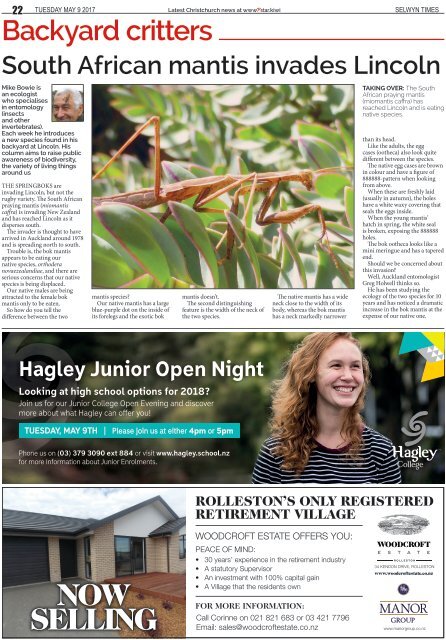Create successful ePaper yourself
Turn your PDF publications into a flip-book with our unique Google optimized e-Paper software.
22 Tuesday <strong>May</strong> 9 <strong>2017</strong><br />
Latest Christchurch news at www. .kiwi<br />
Backyard critters<br />
SELWYN TIMES<br />
South African mantis invades Lincoln<br />
Mike Bowie is<br />
an ecologist<br />
who specialises<br />
in entomology<br />
(insects<br />
and other<br />
invertebrates).<br />
Each week he introduces<br />
a new species found in his<br />
backyard at Lincoln. His<br />
column aims to raise public<br />
awareness of biodiversity,<br />
the variety of living things<br />
around us<br />
THE SPRINGBOKS are<br />
invading Lincoln, but not the<br />
rugby variety. The South African<br />
praying mantis (miomantis<br />
caffra) is invading New Zealand<br />
and has reached Lincoln as it<br />
disperses south.<br />
The invader is thought to have<br />
arrived in Auckland around 1978<br />
and is spreading north to south.<br />
Trouble is, the bok mantis<br />
appears to be eating our<br />
native species, orthodera<br />
novaezealandiae, and there are<br />
serious concerns that our native<br />
species is being displaced.<br />
Our native males are being<br />
attracted to the female bok<br />
mantis only to be eaten.<br />
So how do you tell the<br />
difference between the two<br />
mantis species?<br />
Our native mantis has a large<br />
blue-purple dot on the inside of<br />
its forelegs and the exotic bok<br />
mantis doesn’t.<br />
The second distinguishing<br />
feature is the width of the neck of<br />
the two species.<br />
The native mantis has a wide<br />
neck close to the width of its<br />
body, whereas the bok mantis<br />
has a neck markedly narrower<br />
TAKING OVER: The South<br />
African praying mantis<br />
(miomantis caffra) has<br />
reached Lincoln and is eating<br />
native species. <br />
than its head.<br />
Like the adults, the egg<br />
cases (ootheca) also look quite<br />
different between the species.<br />
The native egg cases are brown<br />
in colour and have a figure of<br />
888888-pattern when looking<br />
from above.<br />
When these are freshly laid<br />
(usually in autumn), the holes<br />
have a white waxy covering that<br />
seals the eggs inside.<br />
When the young mantis’<br />
hatch in spring, the white seal<br />
is broken, exposing the 888888<br />
holes.<br />
The bok ootheca looks like a<br />
mini meringue and has a tapered<br />
end.<br />
Should we be concerned about<br />
this invasion?<br />
Well, Auckland entomologist<br />
Greg Holwell thinks so.<br />
He has been studying the<br />
ecology of the two species for 10<br />
years and has noticed a dramatic<br />
increase in the bok mantis at the<br />
expense of our native one.<br />
Hagley Junior Open Night<br />
Looking at high school options for 2018?<br />
Join us for our Junior College Open Evening and discover<br />
more about what Hagley can offer you!<br />
TUESDAY, MAY 9TH | Please join us at either 4pm or 5pm<br />
Phone us on (03) 379 3<strong>09</strong>0 ext 884 or visit www.hagley.school.nz<br />
for more information about Junior Enrolments.<br />
ROLLEStON’S ONLy REGIStERED<br />
REtIREMENt vILLaGE<br />
NOW<br />
SELLING<br />
WoodCroFt EstAtE oFFErs YoU:<br />
PEACE oF Mind:<br />
• 30 years’ experience in the retirement industry<br />
• A statutory Supervisor<br />
• An investment with 100% capital gain<br />
• A Village that the residents own<br />
FOR MORE INFORMATION:<br />
Call Corinne on 021 821 683 or 03 421 7796<br />
Email: sales@woodcroftestate.co.nz<br />
34 kEndon drivE, rollEston<br />
www.manorgroup.co.nz


















